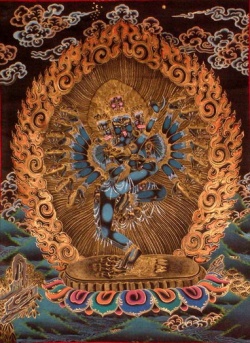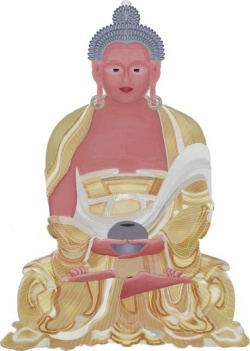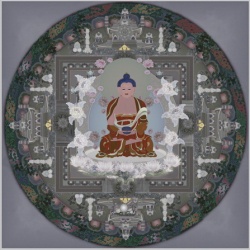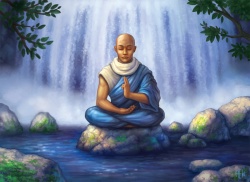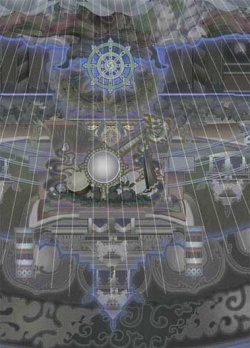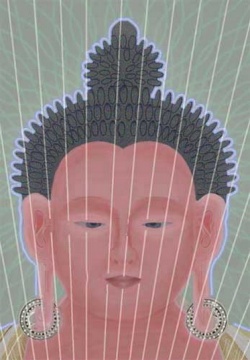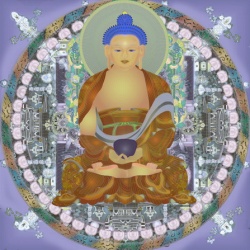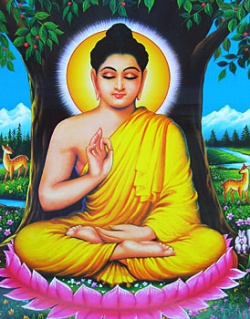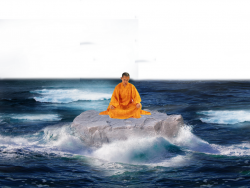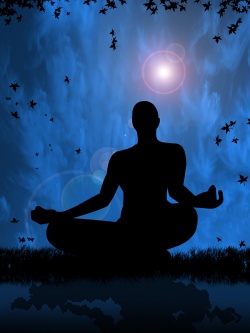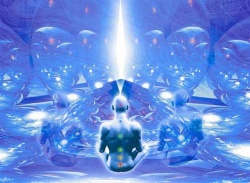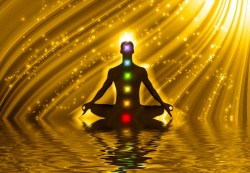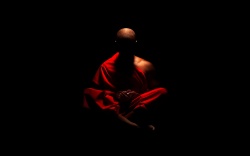Dhyana
Dhyana (bsam gtan). The state of concentrated mind and also the name for god realms produced through such mental concentration. dhyana (jhana, ch’an, sam ten): Literally trance or absorption.
A deep meditative state or absorption characterized by lucid awareness and achieved by focusing the mind on a single object. General word for meditation or concentration and the fifth of the six paramitas.
The Sanskrit word that was transliterated by the Chinese into Ch’an and then from the Chinese by the Japanese into Zen. Also used to refer to the four levels of concentration. A meditative absorption state.
See “meditation” and the “Shurangama Sutra” for a description of the four dhyanas and the “Cula-suññata Sutta” for a description of the four formless dhyanas or jhanas.
See also; “Thirty-one Planes of Existence.”
See also; under 'four dhyana states.'
Dhyāna (Sanskrit; Devanagari: ध्यान) or Jhāna (झान) (Pāli) is a form of Buddhist meditation.
It refers to various states of samadhi, a state of consciousness in which the observer detaches from several qualities of the mind.
In this state the mind has become firm and stable and the ability to concentrate is greatly enhanced.
Dhyana proper is the concentration of the mind, resulting in samadhi.
The Sutta Pitaka describes four levels of dhyana, called jhana, each of increasing depth.
The Jhanas are described many times in the Pāli canon, and a great deal of the post-canonical Theravāda Buddhist and Mahayana literature have been devoted to its elucidation.
The Zen-tradition has been named after this meditative state, though in Chinese Buddhism dhyana may refer to all kind of meditation techniques and their preparatory practices which can be used to attain samadhi.
Very little scientific study have been conducted on these states.
The most notable are those of neurologist Professor James H. Austin.
The jhanas in the early suttas
The jhānas are states of meditation where the mind is free from the five hindrances — craving, aversion, sloth, agitation and doubt — and (from the second jhāna onwards) incapable of discursive thinking.
In the early texts, the jhanas are taught as a state of collected, full-body awareness in which mind becomes very powerful and still but not frozen, and is thus able to observe and gain insight into the changing flow of experience.
The Buddha's instructions on attaining jhana are via mindfulness of breathing, found in the Ānāpānasati Sutta and elsewhere.
Dhyana, or samadhi, alone is not enough to attain liberation.
According to the Theravada tradition it must be combined with vipassana, which gives insight into the three marks of existence and leads to detachment and "the manifestation of the path".
Later Theravada literature, in particular the Visuddhimagga, describes it as an abiding in which the mind becomes fully immersed and absorbed in the chosen object of attention, characterized by non-dual consciousness.
Appanà samàdhi
The First to Fourth Jhanas may also be described collectively by the term appanà samàdhi.
When disciples of the Buddha use the word jhana now, it is generally understood to refer collectively to the First to Fourth Jhanas in particular.
In its early use, the word jhana can be understood to have meant any meditation in general. Early Buddhism considered only the First to Fourth Jhanas as right meditation.
Over time, the word jhana began to take on this particular meaning among many of his disciples, while excluding other types of meditation practised contemporaneously to the Buddha, such as appana-kam jhana (involving suppression of breathing, typically causing great pain) or sensual meditation focusing on an object.
For this reason, the word jhana can sometimes be seen used in its earlier meaning to refer to 'meditation' in general, and on other occasions the word jhana can be seen used collectively to denote all four of the Jhanas taught as right meditation by the Buddha.
Usage by the Buddha
The Buddha himself entered jhāna, as described in the early texts, during his own quest for enlightenment.
The meditations he learned (that were not of jhana) did not lead to nibbana.
He then underwent harsh ascetic practices with which he eventually also became disillusioned.
He subsequently remembered entering jhāna as a child, and realized that "that indeed is the path to enlightenment."
According to the Maha-Saccaka Sutta, the Buddha recalled a meditative state he entered by chance as a child and abandoned the ascetic practices he has been doing:
- I thought: 'I recall once, when my father the Sakyan was working, and I was sitting in the cool shade of a rose-apple tree, then — quite secluded from sensuality, secluded from unskillful mental qualities —
I entered & remained in the first jhana: rapture & pleasure born from seclusion, accompanied by directed thought & evaluation.
Could that be the path to Awakening?' Then following on that memory came the realization: 'That is the path to Awakening.'
According to the Upakkilesa Sutta, after figuring out the cause of the various obstacles and overcoming them, the Buddha was able to penetrate the sign and enters 1st–4th Jhana:
Shortly after the vision of light and shapes disappear.
I thought, ‘What is the cause and condition in which light and vision of the forms disappear?'
Then consider the following:
‘The question arose in me and because of doubt my concentration fell, when my concentration fell, the light disappeared and the vision of forms. I act so that the question does not arise in me again.'
- I remained diligent, ardent, perceived both the light and the vision of forms. Shortly after the vision of light and shapes disappear. I thought,
'What is the cause and condition in which light and vision of the forms disappear?'
Then consider the following: 'Inattention arose in me because of inattention and my concentration has decreased, when my concentration fell, the light disappeared and the vision of forms.
I must act in such a way that neither doubt nor disregard arise in me again.'
In the suttas the Buddha is depicted many times encouraging his disciples to develop jhāna as a way of achieving awakening and liberation.
Just before his passing away, The Buddha entered the jhānas in direct and reverse order, and the passing away itself took place after rising from the fourth jhāna.
Stages of jhāna
The Pāli canon describes eight progressive states of jhāna. Four are called meditations of form (rūpa jhāna), and four are formless meditations (arūpa jhāna).
The Rupa Jhānas
There are four stages of deep collectedness which are called the Rupa Jhāna (Fine-material Jhāna).
Description of the Four Rupa Jhanas
For each Jhāna are given a set of qualities which are "ferreted them out one after another" and "vanish":
- First Jhāna — In the first jhana there are: "directed thought, evaluation, rapture, pleasure, unification of mind, contact, feeling, perception, intention, consciousness, desire, decision, persistence, mindfulness, equanimity & attention"
- Second Jhāna — In the second jhana there are: "internal assurance, rapture, pleasure, unification of mind, contact, feeling, perception, intention, consciousness, desire, decision, persistence, mindfulness, equanimity, & attention"
- Third Jhāna — In the third jhana, there are: "equanimity-pleasure, unification of mind, contact, feeling, perception, intention, consciousness, desire, decision, persistence, mindfulness, equanimity & attention"
- Fourth Jhāna — In the fourth jhana there are: "a feeling of equanimity, neither pleasure nor pain; an unconcern due to serenity of awareness; unification of mind, contact, feeling, perception, intention, consciousness, desire, decision, persistence, mindfulness, equanimity & attention".
Jhana Factors
Jhānas are normally described according to the nature of the mental factors which are present in these states:
- Movement of the mind onto the object (vitakka; Sanskrit: vitarka)
- Retention of the mind on the object (vicāra)
- Joy (pīti; Sanskrit: prīti)
- Happiness (sukha)
- Equanimity (upekkhā; Sanskrit: upekṣā)
- One-pointedness (ekaggatā; Sanskrit: ekāgratā)
Factors per Jhana
The qualities that remain in each jhana are:
The five hindrances have completely disappeared and intense unified bliss remains.
Only the subtlest of mental movement remains, perceivable in its absence by those who have entered the second jhāna. The ability to form unwholesome intentions ceases.
- Second jhāna (pīti, sukha, ekaggatā): All mental movement utterly ceases. There is only bliss. The ability to form wholesome intentions ceases as well.
- Third jhāna (sukha, ekaggatā): One-half of bliss (joy) disappears.
- Fourth jhāna (upekkhā, ekaggatā): The other half of bliss (happiness) disappears, leading to a state with neither pleasure nor pain, which the Buddha said is actually a subtle form of happiness (more sublime than pīti and sukha). The breath is said to cease temporarily in this state.
Psychic powers
Traditionally, the fourth jhāna is seen as the beginning of attaining psychic powers (abhigna).
The Arupa Jhānas
Beyond the four jhānas lie four attainments, referred to in the early texts as aruppas.
These are also referred to in commentarial literature as immaterial/the formless jhānas (arūpajhānas), also translated as The Formless Dimensions, in distinction from the first four jhānas (rūpa jhānas).
In the Buddhist canonical texts, the word "jhāna" is never explicitly used to denote them, but they are always mentioned in sequence after the first four jhānas.
The immaterial attainments have more to do with expanding, while the Jhanas (1-4) focus on concentration.
The enlightenment of complete dwelling in emptiness is reached when the eighth jhāna is transcended.
The four formless jhanas are:
- Dimension of Infinite Space — In the dimension of infinite space there are:
"the perception of the dimension of the infinitude of space,
unification of mind, contact, feeling, perception, intention, consciousness, desire, decision, persistence, mindfulness, equanimity, & attention"
- Dimension of Infinite Consciousness — In the Dimension of infinite consciousness there are: "the perception of the dimension of the infinitude of consciousness, unification of mind, contact, feeling, perception, intention, consciousness, desire, decision, persistence, mindfulness, equanimity, & attention"
- Dimension of Nothingness — In the dimension of nothingness, there are: "the perception of the dimension of nothingness, singleness of mind, contact, feeling, perception, intention, consciousness, desire, decision, persistence, mindfulness, equanimity, & attention"
- Dimension of Neither Perception nor Non-Perception — About the role of this jhana it is said: "He emerged mindfully from that attainment. On emerging mindfully from that attainment, he regarded the past qualities that had ceased & changed:
'So this is how these qualities, not having been, come into play.
Having been, they vanish.' He remained unattracted & unrepelled with regard to those qualities, independent, detached, released, dissociated, with an awareness rid of barriers.
He discerned that 'There is a further escape,' and pursuing it there really was for him."
Nirodha-Samapatti
The Buddha also rediscovered an attainment beyond the dimension of neither perception nor non-perception, Nirodha-Samapatti, the "cessation of feelings and perceptions."
This is sometimes called the "ninth jhāna" in commentarial and scholarly literature.
About this, it is said:
- Seeing with discernment, his fermentations were totally ended.
He emerged mindfully from that attainment. On emerging mindfully from that attainment, he regarded the past qualities that had ceased & changed: '
So this is how these qualities, not having been, come into play. Having been, they vanish.'
He remained unattracted & unrepelled with regard to those qualities, independent, detached, released, dissociated, with an awareness rid of barriers. He discerned that 'There is no further escape,' and pursuing it there really wasn't for him.
According to some traditions someone attaining this state is an anagami or an arahant.
In the above extract, the Buddha narrates that Sariputta became an arahant upon reaching it.
Although the "Dimension of Nothingness" and the "Dimension of [[Neither Perception nor Non-Perception\\" are included in the list of nine Jhanas taught by the Buddha, they are not included in the Noble Eightfold Path.
Noble Path number eight is "Samma Samadhi" (Right Concentration), and only the first four Jhanas are considered "Right Concentration".
If he takes a disciple through all the Jhanas, the emphasis is on the "Cessation of Feelings and Perceptions" rather than stopping short at the "Dimension of Neither Perception nor Non-Perception".
Jhana as an aid to attaining insight
- See also: Vipassana and Sampajañña
The meditator uses the jhāna state to bring the mind to rest, and to strengthen and sharpen the mind, in order to investigate the true nature of phenomena (dhamma) and to gain higher knowledge.
The longer the meditator stays in the state of jhāna the sharper and more powerful the mind becomes.
As the five hindrances may be suppressed for days after entering jhāna, the meditator will feel perfectly clear, mindful, full of compassion, peaceful and light after the meditation session.
This, according to Ajahn Brahm, may cause some meditators to mistakenly assume that they have gained enlightenment.
The jhāna state cannot by itself lead to enlightenment as it only suppresses the defilements.
Meditators must use the jhāna state as an instrument for developing wisdom by cultivating insight and use it to penetrate the true nature of phenomena through direct cognition, which will lead to cutting off the defilements and nibbana.
According to the later Theravāda commentorial tradition as outlined by Buddhagoṣa in his Visuddhimagga, after coming out of the state of jhāna the meditator will be in the state of post-jhāna access concentration.
This will have the qualities of being certain, long-lasting and stable.
It is where the work of investigation and analysis of the true nature of phenomena begins and is also where deep insight into the characteristics of impermanence, suffering and not-self arises.
The meditator can experience these truths, which lie at the heart of the Buddha's teachings, through direct experience.
In contrast, according to the sutta descriptions of jhāna practice, the meditator does not emerge from jhāna to practice vipassana but rather the work of insight is done whilst in jhāna itself.
In particular the meditator is instructed to "enter and remain in the fourth jhāna" before commencing the work of insight in order to uproot the mental defilements:
- With the abandoning of pleasure and pain — as with the earlier disappearance of elation and distress — he enters and remains in the fourth jhāna: purity of equanimity and mindfulness, neither-pleasure nor pain...
With his mind thus concentrated, purified, and bright, unblemished, free from defects, pliant, malleable, steady, and attained to imperturbability, the monk directs and inclines it to the knowledge of the ending of the mental fermentations.
He discerns, as it has come to be, that 'This is suffering... This is the origination of suffering... This is the cessation of suffering... This is the way leading to the cessation of suffering...
These are mental fermentations... This is the origination of fermentations... This is the cessation of fermentations... This is the way leading to the cessation of fermentations.'
Mastering the jhanas
The scriptures state that one should not seek to attain ever higher jhānas but master one first, then move on to the next.
Mastery of jhāna involves being able to enter a jhāna at will, stay as long as one likes, leave at will and experience each of the jhāna factors as required.
They also seem to suggest that lower jhāna factors may manifest themselves in higher jhāna, if the jhānas have not been properly developed.
The Buddha is seen to advise his disciples to concentrate and steady the jhāna further.
The early suttas state that "the most exquisite of recluses" is able to attain any of the jhānas and abide in them without difficulty.
This particular arahant is "liberated in both ways:" he is fluent in attaining the jhānas and is also aware of their ultimate unsatisfactoriness.
If he were not, he would fall into the same problem as the teachers from whom the Buddha learned the spheres of nothingness and neither perception nor non-perception, in seeing these meditative attainments as something final. Their problem lay in seeing permanence where there is impermanence.
Aspects of jhana mastery
A meditator should first master the lower jhānas, before they can go into the higher jhānas.
There are five aspects of jhāna mastery:
- Mastery in adverting: the ability to advert to the jhāna factors one by one after emerging from the jhāna, wherever he wants, whenever he wants, and for as long as he wants.
- Mastery in attaining: the ability to enter upon jhāna quickly.
- Mastery in resolving: the ability to remain in the jhāna for exactly the pre-determined length of time.
- Mastery in emerging: the ability to emerge from jhāna quickly without difficulty.
- Mastery in reviewing: the ability to review the jhāna and its factors with retrospective knowledge immediately after adverting to them.
Preliminary stage
The Buddha explains right concentration (samma samādhi), part of the noble eightfold path, as the four first jhānas.
According to the Pāli canon commentary, there is a certain stage of meditation that the meditator should reach before entering into jhāna.
This stage is access/neighbourhood concentration (upacāra-samādhi).
The overcoming of the five hindrances — sensual desire, ill will, sloth and torpor, restlessness and worry and doubt — marked the entries into access concentration.
This concentration is an unstable state where the mind becomes well concentrated on an object but it is still not yet a state of "full concentration" (jhāna).
The difference is, in full concentration certain factors become strengthened to such a degree that they bring about a qualitative shift in the level of consciousness and the mind no longer functions on the ordinary sensory level.
Access concentration is not mentioned in the discourses of the Buddha. However there are several suttas where a person gains insight into the Dhamma on hearing a teaching from the Buddha.
Often their minds are described as being free from hindrances when this occurs and some have identified this as being a type of access concentration.
The equivalent of upacāra-samādhi used in Tibetan commentaries is nyer-bsdogs.
At the state of access concentration, some meditators may experience vivid mental imagery (Pāli: nimitta), which is similar to a vivid dream — as vividly as if seen by the eye, but in this case the meditator is fully aware and conscious that they are seeing mental images. This is discussed in the early texts, and expanded upon in Theravāda commentaries.
Different meditators will experience different mental images; some meditators may not experience any mental images at all.
The same meditator doing multiple meditation sessions may experience different mental images for each session.
The mental image may be pleasant, frightening, disgusting, shocking or neutral.
As the concentration becomes stronger, the feelings of breathing and of having a physical body will completely disappear, leaving only pure awareness.
At this stage inexperienced meditators may become afraid, thinking that they are going to die if they continue the concentration because the feeling of breathing and the feeling of having a physical body has completely disappeared.
They should not be so afraid and should continue their concentration in order to reach "full concentration" (jhāna).
Parallels with Patanjali's Ashtanga Yoga
There are parallels with the fourth to eighth stages of Patanjali's Ashtanga Yoga, as mentioned in his classical work, Yoga Sutras of Patanjali's composed in the 2nd century BCE.
Patanjali's discerns bahiranga (external) aspects of yoga namely, yama, niyama, asana, pranayama, and the antaranga (internal) yoga.
Having actualized the pratyahara stage, a practitioner is able to effectively engage into the practice of Samyama.
At the stage of pratyahara, the consciousness of the individual is internalized in order that the sensations from the senses of taste, touch, sight, hearing and smell don't reach their respective centers in the brain and takes the sadhaka (practitioner) to next stages of Yoga, namely Dharana (concentration), Dhyana (meditation), and Samadhi (mystical absorption), being the aim of all Yogic practices.
Parallels in Brahmanical texts
Alexander Wynne
Alexander Wynne attempted to find parallels in Brahmanical texts to the meditative goals the two teachers claimed to have taught, drawing especially on some of the Upanishads and the Mokshadharma chapter of the Mahabharata.
Reversal of the creation of the world
Wynne claimed that Brahmanic passages on meditation suggest that the most basic presupposition of early Brahmanical yoga is that the creation of the world must be reversed, through a series of meditative states, by the yogin who seeks the realization of the self.
These states were given doctrinal background in early Brahmanic cosmologies, which classified the world into successively coarser strata.
One such stratification is found at TU II.1 and Mbh XII.195, and proceeds as follows:
self, space, wind, fire, water, earth.
Mbh XII.224 gives alternatively:
Brahman, mind, space, wind, fire, water, earth.
In Brahmanical thought, the meditative states of consciousness were thought to be identical to the subtle strata of the cosmos.
There is no similar theoretical background to element meditation in the early Buddhist texts, where the elements appear simply as suitable objects of meditation.
It is likely that the Brahmanic practices of element-meditation were borrowed and adapted by early Buddhists, with the original Brahmanac ideology of the practices being discarded in the process.
Investigation of self
On this point, it is thought that the uses of the elements in early Buddhist literature have in general very little connection to Brahmanical thought; in most places they occur in teachings where they form the objects of a detailed contemplation of the human being.
The aim of these contemplations seems to have been to bring about the correct understanding that the various perceived aspects of a human being, when taken together, nevertheless do not comprise a 'self'.
Moreover, the self is conceptualized in terms similar to both "nothingness" and "neither perception nor non-perception" at different places in early Upanishadic literature.
The latter corresponds to Yajnavalkya’s definition of the self in his famous dialogue with Maitreya in the Brihadaranyaka Upanishad and the definition given in the post-Buddhist Mandukya Upanishad.
This is mentioned as a claim of non-Buddhist ascetics and Brahmins in the Pañcattaya Sutta (Majjhima Nikaya 102.2).
In the same dialogue in the Brihadaranyaka Upanishad, Yajnavalkya draws the conclusions that the self that is neither perceptive nor non-perceptive is a state of consciousness without object. The early Buddhist evidence suggests much the same thing for the state of "neither perception nor non-perception".
It is a state without an object of awareness, that is not devoid of awareness.
The state following it in the Buddhist scheme, the "cessation of perception and sensation", is devoid not only of objectivity, but of subjectivity as well.
Uddaka Ramaputta and Alara Kalama
It is suggested that Uddaka Ramaputta belonged to the pre-Buddhist tradition portrayed by the Buddhist and Brahmanic sources, in which the philosophical formulations of the early Upanishads were accepted and the meditative state of "neither perception nor non-perception" was equated with the self.
Furthermore, he suggested that the goal of Alara Kalama was a Brahminical concept.
Evidence in the Chandogya Upanishad and the Taittiriya Upanishad suggests that a different early Brahmanic philosophical tradition held the view that the unmanifest state of Brahman was a form of non-existence.
Thus it seems likely that both element and formless meditation was learned by the Buddha from his two teachers and adapted by him to his own system.
Influence on Hinduism
While the Buddha was not the first to attain the formless meditative absorption, the stratification of particular samādhi experiences into the four jhānas seems to be a Buddhist innovation.
It was then borrowed and presented in an incomplete form in the Mokṣadharma, a part of the Mahābhārata.
It appears that in early Brahmanic yoga, the formless spheres were attained following element meditation. This is also taught as an option in the early Buddhist texts.
The primary method taught to achieve the formless attainment in early Buddhist scriptures, on the other hand, is to proceed to the sphere of infinite space following the fourth jhāna.
Criticism of pre-Buddhist claim
- See also: Soteriology in Hinduism and Buddhism
The Brahmanical texts cited by Wynne assumed their final form long after the Buddha’s lifetime.
The Mokshadharma postdates him. Samadhi was first found in the Tipitaka and not in any pre-Buddhist text.
But it was later incorporated into later texts such as the Maitrayaniya Upanishad.
Uddaka Ramaputta and Alara Kalama
The texts, cited by Alexander Wynne in an attempt to find parallels in Brahmanical texts to the meditative goals Uddaka Ramaputta and Alara Kalama claimed to have taught, assumed their final form long after the Buddha’s lifetime.
Upanishads
It is important to note that of the 200 or so Upanishads, only the first 10 or 12 are considered the oldest and principal Upanishads. Among these 10 or 12 principal Upanishads, the Taittiriya, Aitareya and Kausitaki show Buddhist influence.
The Brihadaranyaka, Jaiminiya-Upanisad-Brahmana and the Chandogya Upanishads were composed during the pre-Buddhist era while the rest of these 12 oldest Upanishads are dated to the last few centuries BCE.
Nevertheless, "the terms dhyana and samahita (entering samadhi) appear already in Upanishadic texts that predate the origins of Buddhism".
Patanjali's Yoga Sutras
The Eight Limbs of the yoga sutras show Samadhi as one of its limbs.
But the Eight limbs of the Yoga Sutra was only developed after the Buddha and is influenced by the Buddha’s Eightfold Path.
The suttas show that during the time of the Buddha Nigantha Nataputta, the Jain leader, did not even believe that it is possible to enter a state where the thoughts and examination stop.
Samadhi
Rhys Davids and Maurice Walshe agreed that the term "samadhi" is not found in any pre-buddhist text. Hindu texts later used that term to indicate the state of enlightenment. This is not in conformity with Buddhist usage. According to Maurice Walshe:
- Rhys Davids also states that the term samadhi is not found in any pre-Buddhist text.
To his remarks on the subject should be added that its subsequent use in Hindu texts to denote the state of enlightenment is not in conformity with Buddhist usage, where the basic meaning of concentration is expanded to cover ‘meditation’ in general.
Tripitaka-polemics
Three discourses in the Bhojjhanga-Samyutta present the claims of non-Buddhist wanderers that they too develop Buddhist-style meditationg samādhi.
They ask the Buddha what the difference is between their teachings and his.
He does not respond by teaching right view, but by telling them that they do not fully understand samādhi practice.
Ajahn Sujato interprets this statement as explaining a statement of the Buddha's elsewhere that he "awakened to jhāna"; he was the first to fully comprehend both the benefits and limitations of samādhi experiences.
In Mahāyāna traditions
Mahāyāna Buddhism includes numerous schools of practice.
Each draw upon various Buddhist sūtras, philosophical treatises, and commentaries, and each has its own emphasis, mode of expression, and philosophical outlook.
Accordingly, each school has its own meditation methods for the purpose of developing samādhi and prajñā, with the goal of ultimately attaining enlightenment.
Chán
- See also: Zen, Chinese Chán, Japanese Zen, and Zen in the United States
In China, the word "dhyāna" was originally transliterated as chánnà (禪那), and shortened to just chán (禪) by common usage.
In Chinese Buddhism dhyana may refer to all kind of meditation techniques and their preparatory practices which can be used to attain samadhi.
The word chán became the desination for the Chán school (Jp. Zen).
Dhyana is a central aspect of Buddhist practice in Chán.
In his classic book on meditation of the various Chinese Buddhist traditions, Charles Luk writes,
- The Buddha Dharma is useless if it is not put into actual practice, because if we do not have personal experience of it, it will be alien to us and we will never awaken to it in spite of our book learning."
Venerable Nan Huaijin echoes similar sentiments about the importance of meditation by remarking,
- Intellectual reasoning is just another spinning of the sixth consciousness, whereas the practice of meditation is the true entry into the Dharma."
Hui-neng and the Platform Sutra
In the Platform Sutra, Hui Neng says:
- To concentrate the mind and to contemplate it until it is still is a disease and not Zen.
" He goes on to say that the meditator who enters a state in which thoughts are suppressed must allow them to arise naturally once again.
Chán-description of the Jhanas
Venerable Hsuan Hua, who taught Chán and Pure Land Buddhism, outlines the four preliminary stages of dhyāna:
The external breathing stops, while the internal breathing comes alive, and it is said that the mind is as clear as water and as bright as a mirror.
When the external breathing stops, the nose and mouth do not breathe.
While in this state, the mind and body have a feeling of existing within empty space.
- In the Second Dhyāna, there is pure bliss born from samādhi.
In this stage, there is said to be happiness without compare.
After reaching this stage, it is said that some practitioners may go without food or water for many days and still be alright.
When in this second stage, not only does the external breathing stop, but the pulse comes to a stop as well.
After leaving this state, the pulse resumes its normal function.
- In the Third Dhyāna, the joy of the previous stages is left, leaving only a subtle and blissful peace.
At this stage it is said that not only do the breathing and pulse stop, but idle thoughts stop as well.
Although idle thoughts have been cleared away, it is emphasized that this stage is nothing special, and just part of the progression.
At this stage, the body becomes as soft as the body of an infant.
Softness and suppleness of the body is considered to be a physical indicator of the quality of an individual's samādhi. Nan Huaijin states:
"All the eminent monks of great virtue in the past were able to predict what day they would die, and even on the brink of death their bodies were as soft and supple as a baby's.
Others who were even more lofty turned into a field of light, and their human forms disappeared. At most all they left behind were a few pieces of fingernail, or a lock of hair as a memento."
- In the Fourth Dhyāna, the only manifestation is that of complete purity and perfection.
At this stage one is still considered the stage of an ordinary mortal, and still far from the Nirvāṇa of the fully enlightened buddhas.
In the tradition of Chinese Buddhism, it is said that those individuals who have reached this stage sometimes choose to walk with their feet one inch above the eartho they do not harm any living beings.
Dispute about dhyana in Chán
Some scholars and various authors have claimed that Chán/Zen Buddhism does not utilize the stages of dhyāna.
This is contradicted by statements from well known exponents of Chán Buddhism such as Venerable Sheng Yen, Venerable Hsuan Hua, and Venerable Nan Huaijin.
Sheng Yen, a Buddhist monk and scholar from the Linji and Caodong lineages of the Chán school, clarifies that the Chán/Zen school does indeed include the dhyānas:
- Although the Chán school definitely advocates practicing meditation to reach absorption states (dhyāna), not all meditative absorption states are those of the Chán school.
Sheng Yen also cites meditative concentration as necessary, citing samādhi as one of the requisite factors for progress on the path toward enlightenment.
Nan Huaijin also agrees about the dhyanas being necessary in Chán Buddhism, and regarding the various stages, he states, "Real cultivation going toward samādhi goes through the four dhyānas."
Sheng Yen clarifies that the eight dhyānas are to be understood as mundane meditative states, which are also shared by practitioners on "outer paths", as well as ordinary people, or in principle even animals. He characterizes these as intermediate steps for supramundane realization in dhyāna.
Vajrayāna
B. Alan Wallace holds that modern Tibetan Buddhism lacks emphasis on achieving levels of concentration higher than access concentration.
According to Wallace, one possible explanation for this situation is that virtually all Tibetan Buddhist meditators seek to become enlightened through the use of tantric practices.
These require the presence of sense desire and passion in one's consciousness, but jhāna effectively inhibits these phenomena.
While few Tibetan Buddhists, either inside or outside Tibet, devote themselves to the practice of concentrationn Buddhist literature does provide extensive instructions on it, and great Tibetan meditators of earlier times stressed its importance.
All this being said, Wallace has translated and commented on Tsongkapa's Stages of the Path, a Tibetan classic on this topic, in his book Balancing the Mind.
It is a very intricate guide on mastering equanimity and insight during meditationh of which are claimed to be required to advance up the jhanas.
Scientific studies
There has been little scientific study of these mental states.
In 2008, an EEG study found "strong, significant, and consistent differences in specific brain regions when the meditator is in a jhana state compared to normal resting consciousness".
Tentative hypotheses on the neurological correlates have been proposed, but lack supporting evidence.
